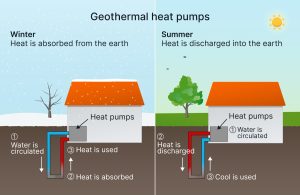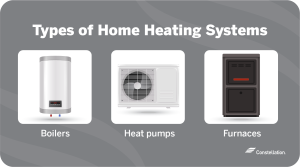


Heating and Cooling Systems in Eastern Ontario Homes
Why HVAC Matters
Heating and cooling systems (HVAC — Heating, Ventilation, and Air Conditioning) are essential for comfort, efficiency, and safety in Eastern Ontario’s four-season climate. With long, cold winters and hot, humid summers, homeowners need systems that can handle extremes while keeping energy costs under control.
Heating Systems
1. Forced-Air Furnaces
-
How It Works: Burns natural gas, propane, oil, or uses electricity to heat air, then distributes it through ductwork.
-
Pros: Quick, even heating; can integrate with central AC; supports air filters/humidifiers.
-
Cons: Duct leaks reduce efficiency; can dry out air; older oil systems are less eco-friendly.
-
Regional Use: The most common system in suburban homes around Belleville, Quinte, and PEC.
2. Boilers (Hydronic Heating)
-
How It Works: Heats water with gas, oil, or electricity; circulates through radiators, baseboards, or in-floor radiant pipes.
-
Pros: Comfortable, consistent heat; quieter than forced air; radiant systems feel luxurious.
-
Cons: No built-in cooling; slower to adjust; installation costlier.
-
Regional Use: Popular in heritage homes, older urban housing, and upscale custom builds with radiant floors.
3. Electric Baseboards
-
How It Works: Electric resistance heaters installed along baseboards, controlled room by room.
-
Pros: Simple, inexpensive upfront; no ducts needed; zoned heating.
-
Cons: High operating costs; limited efficiency.
-
Regional Use: Found in cottages, small homes, and rental units.
4. Wood, Pellet, and Gas Stoves/Fireplaces
-
How It Works: Burns wood, pellets, or gas for localized heat.
-
Pros: Cozy, aesthetic appeal; can reduce heating bills; backup during power outages.
-
Cons: Requires venting, maintenance, and fuel storage; not whole-home heating.
-
Regional Use: Very common in rural Eastern Ontario, especially in farmhouses and cottages.
5. Heat Pumps (Air-Source and Ground-Source/Geothermal)
-
How It Works: Transfers heat instead of generating it. Air-source uses outdoor air; geothermal draws from the ground.
-
Pros: Provides both heating and cooling; energy-efficient; lowers carbon footprint.
-
Cons: Higher upfront costs; air-source less efficient in extreme cold (though modern models perform well).
-
Regional Use: Growing popularity as Ontario shifts toward greener solutions, especially in new builds.
Cooling Systems
1. Central Air Conditioning
-
How It Works: Uses an outdoor compressor and indoor coil to cool air, distributing it through ducts.
-
Pros: Whole-home comfort; pairs with forced-air furnace.
-
Cons: Duct-dependent; higher energy use.
-
Regional Use: Standard in most suburban homes with existing ductwork.
2. Ductless Mini-Split Systems
-
How It Works: Wall- or ceiling-mounted indoor units connected to an outdoor compressor.
-
Pros: No ducts required; energy-efficient; zoned control.
-
Cons: Visible indoor units; higher upfront cost than window units.
-
Regional Use: Ideal for older homes without ducts, additions, or rural properties.
3. Window and Portable Units
-
How It Works: Self-contained systems installed in windows or on the floor with venting.
-
Pros: Low cost; easy to install.
-
Cons: Limited coverage; noisy; less efficient.
-
Regional Use: Common in apartments, rentals, and cottages.
4. Heat Pumps (Again)
-
Because they provide both heating and cooling, heat pumps are a versatile all-in-one solution — increasingly used as a primary system in modern Ontario homes.
Climate and Regional Considerations
-
Cold Winters: Natural gas furnaces remain the dominant choice in cities with gas lines, while propane and oil are common in rural areas.
-
Energy Efficiency: With rising utility costs, more homeowners are investing in heat pumps, geothermal systems, and high-efficiency furnaces.
-
Backup Heat: Many rural homes keep wood or pellet stoves for backup during winter power outages.
-
Cooling Demand: While older homes relied on breezes or window units, central AC and ductless systems are now standard in most modern builds.
👉 In summary, Eastern Ontario homes feature a wide range of heating and cooling systems — from traditional furnaces and boilers to modern heat pumps and radiant floors. The right choice depends on the home’s age, location, and the balance between upfront investment and long-term comfort.

